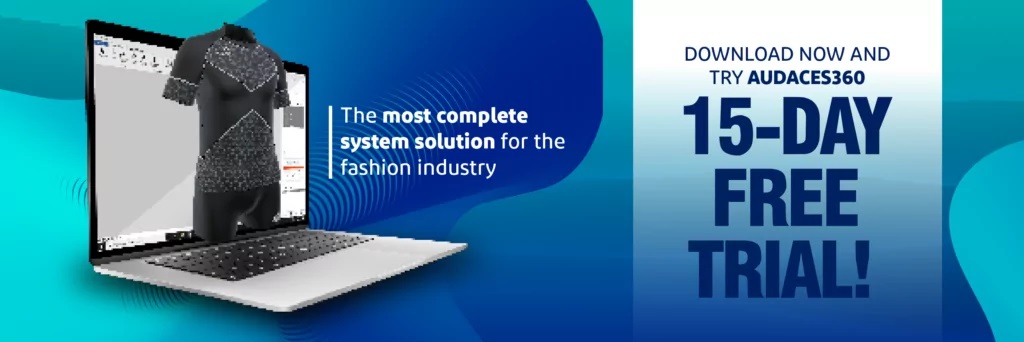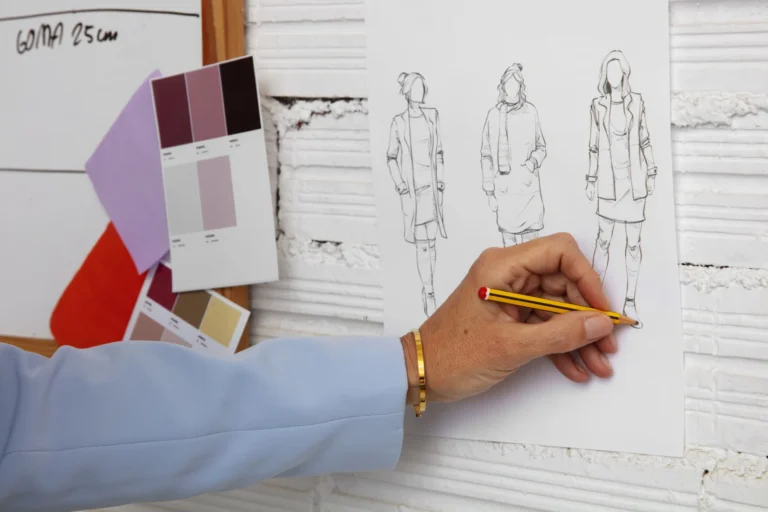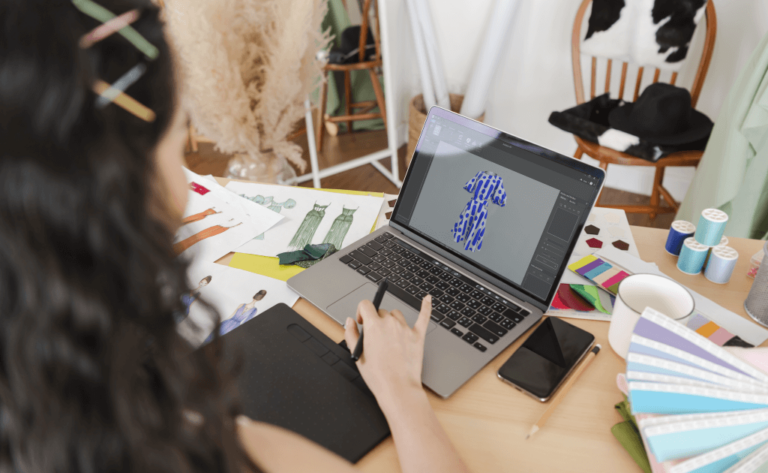Summary
- Acquiring essential skills in how to draw a coat using fashion software helps enhance your fashion collection.
- This knowledge enables you to gain speed, promote sustainability, and save on raw materials.
- Effortlessly plan your collection with the Audaces360 multi-solution – experience the free trial today!
Mastering the skills of how to draw a coat is crucial for any fashion designer. Unleashing your creativity through precise designs not only facilitates detailed adjustments but also fosters effective team communication within the realm of fashion.
Various elements such as length, collar styles, sleeves, closures, and intricate details allow designers to create truly unique and captivating styles.
Embark on a journey to uncover the secrets of how to design a coat and deliver unparalleled fashion experiences to your consumers.
Enjoy the read!
Sumário
What’s the importance of knowing how to draw various coat cuts?
Understanding how to draw different coat cuts holds paramount importance in the realm of fashion. This skill empowers stylists and fashion designers to express creativity and innovation in their creations.
The precision and variety in cut designs play a pivotal role in visualizing how the fabric conforms to the body, enabling professionals to make nuanced adjustments to elements such as collars, sleeves, and lengths.
This proficiency ensures that designers can seamlessly translate their ideas into production, a critical step in guaranteeing that the final piece aligns with the original vision, thereby minimizing errors and the need for rework.
Moreover, detailed drawings foster effective communication among members of a design team, establishing a shared understanding of the project. This not only saves time and resources but also promotes more efficient production processes.
Also, the ability to design different coat cuts equips fashion professionals with the agility to stay abreast of trends and tailor designs to market preferences.
A visual grasp of popular cuts becomes indispensable in creating pieces that not only stand out but also cater to the demands of consumers.
Mastering how to draw a coat in various cuts is, therefore, a fundamental skill that contributes to the success and innovation within the fashion industry.
Learn more: How to create technical drawings online for fashion manufacturing
What are the possible variations when designing a coat?
When it comes to designing a coat, numerous variations can be explored to craft unique styles that cater to diverse tastes, occasions, and current fashion trends.
These variations provide a broad spectrum of options for tailoring coats to different preferences and settings.
By artfully combining these design elements in various ways, many styles and looks can be developed. Let’s explore some possibilities:
Length
- Short: Ends above the waist
- Medium: Reaches waist height
- Long: Extends below the waist
Collar
- High collar: Covers part of the neck
- Open collar: Does not cover the neck
Sleeves
- Long sleeves: Extend to the wrists
- Shorter sleeves: Offer various lengths, typically ending above the elbows
Learn more: 6 tips on how to draw a shirt using technology
Closure
A coat offers various closure options, including the familiar front zipper, the classic button closure, or an open design without any closing elements.
Waist
The waist of a coat can be tailored, providing a snug fit to accentuate the waist for a defined look, or it can be loose and unmarked, offering a more relaxed and comfortable fit.
Pockets
Depending on the chosen model, a coat may feature different types of pockets. These can be situated on the sides, or at the front, or the coat might even be designed without any pockets.
Details
Small details can significantly impact a piece of clothing, even a coat. These details may include pleats that add volume, embroidery with sewn decorative elements, or fabric patches for a personalized touch.
Cut
The cut of your coat can take different forms – a straight cut with simple lines for a classic look, a fitted cut that accentuates the waist curve, or an oversized cut for a broader and looser style. Each cut contributes to the overall aesthetic and feel of the garment.

How to draw a coat directly on the computer?
In the digital realm, drawing a coat directly on the computer is a streamlined process that results in a detailed design, ready for sharing on a technical sheet. This not only simplifies but also enhances the production process within the fashion industry.
Follow these simple steps to master how to draw a coat online:
Learn more: 7 steps to develop your fashion collection planning
Choose a good tool
Opt for design software specifically tailored for the fashion industry, such as Fashion Studio. These tools offer advanced features that facilitate seamless communication between the creative and technical aspects of the design-to-production process.
Learn more: 5 apps to elevate your online fashion design experience
Draw the coat cut
Utilize the drawing tools within your chosen software to sketch the coat’s outline. Begin with the basic shape and gradually refine details like the collar, sleeves, and length according to your design vision.
Add inner linings
Create a separate layer for the coat’s inner lining, ensuring it aligns with the internal dimensions of the garment while matching the external contour.
Add buttons and pockets
Use object insertion or drawing tools to strategically add buttons and pockets to the coat. Consider both design aesthetics and functionality when positioning these elements.
Customize colors and prints
Explore the software’s color palettes and pattern options to paint the coat in your desired colors and add prints if applicable. Ensure that the final design aligns with your original vision.
Transfer to technical sheet
Once your drawing is complete, save it in a compatible format and transfer it to the tech pack or spec sheet. Include additional details such as fabric specifications, dimensions, and any relevant production information.
Learn more: Uncover 5 expert tips on how to create a tech pack successfully
How to improve your coat design with technical details?

To impart a professional touch to coat design, meticulous attention to technical details is essential for elevating the quality of representation.
Here’s how you can improve your coat design with key technical elements:
Incorporate shadows and lines to suggest the fabric type, whether it be the softness of cotton or the thickness of leather. This addition of visual dimension enhances realism in the drawing.
Highlighting the coat’s main features is paramount. Clearly define shoulders, waist, and unique elements such as collars or cuffs. Ensuring balanced proportions contributes to a coherent and stylized shape.
Mark pockets, buttons, and zippers. Insert subtle lines to represent seams and seam allowances, enhancing accuracy in portraying the garment’s construction.
These details not only elevate aesthetics but also aid in effective communication with interpreters, whether they are couturiers or other fashion professionals.
Also, introduce folds and pleats to provide the fabric with movement, simulating its behavior in the real world.
Beyond adding realism, these details underscore attention to the practical aspects of design.
Moreover, use shorter, more spaced lines to suggest lighter fabrics, and employ denser, closer lines for heavier fabrics. This nuanced approach enhances the depiction of various fabric textures.
Achieve perfect fit simulation with Audaces Fashion Studio

Simulating the fit of your coats has never been more seamless and efficient than with Audaces Fashion Studio.
This powerful tool enables you to bring your coat designs to life on a three-dimensional mannequin, transforming your ideas into reality with speed and intuition.
Imagine the freedom of developing collection sketches without the reliance on physical patterns! Audaces Fashion Studio turns this vision into reality, offering innovative technology designed to enhance and expedite the creative process, providing a more agile approach to model creation and approval.
The key differentiator lies in the tool’s ability to simulate the fit of each piece, allowing for realistic visualization even before the production phase begins.
This functionality not only saves time but also enhances precision in the creation process, enabling adjustments and improvements to every detail on the virtual mannequin.
This intuitive tool not only simplifies work but also offers a more detailed view of how each piece complements the collection as a whole.
With Audaces Fashion Studio, the fashion creation process becomes a smarter and more effective experience, putting the power to simulate the fit of your coats and pieces in your hands, in an uncomplicated way.
Now equipped with the essential knowledge, you have what it takes to start designing a coat! Access our e-book to understand the reasons for incorporating 3D virtual design into your collections:
FAQ
Precise cuts help visualize how fabric adjusts to the body, allowing professionals to adjust details like collars, sleeves, and lengths effectively.
Length, collar, sleeves, closure, waist, pockets, details, cut.
Choose a tool, design the coat cut, add an internal lining, incorporate buttons and pockets, customize colors and prints, and transfer the drawing to the technical sheet.










